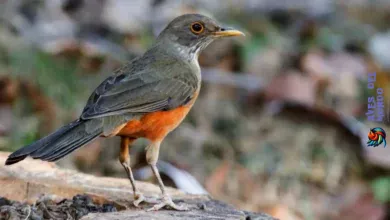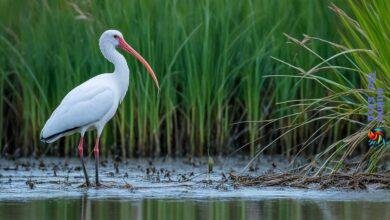Pheasants mainly eat plants, making up to 90% of their diet. This fact truly sets them apart from other farm birds. Those interested in bird feeding tips should pay attention, especially if they want to attract pheasants to their yard. Pheasants have unique needs, preferring a mix of grains, seeds, fruits, and insects. This variety is vital for their health, unlike the simpler diets of chickens and ducks. A bird feeding guide for pheasants is crucial. This is because they can’t forage as freely in captivity.
Want to attract pheasants? You’ll need to know what they eat. This guide goes deep into what food works best for them. With the right information, your yard could become a favorite spot for these birds.
Understanding Pheasant Feeding Habits
Learning about the omnivorous diet of pheasants is very helpful. They like eating both plants and animals, favoring seeds and grains. For feeding wild birds such as pheasants, it’s important to match their natural diet.
The Omnivorous Diet of Pheasants
Pheasants eat many different foods, from insects to all kinds of plants. The best bird seeds meet their need for plants. For DIY bird feeders, adding areas for seeds and grains will attract them. This way, they can forage like they do in the wild, right in your yard.
Foraging Patterns and Preferences
Pheasants are active foragers. They look for foods that give them energy and protein, like fruits, vegetables, and insects. Taking care of bird feeders is crucial. Clean feeders offer food safely and help stop diseases that could hurt these birds.

| Food Type | Benefits for Pheasants | Feeder Tips |
|---|---|---|
| Seeds & Grains | Provides carbohydrates and dietary fiber. | Clean regularly to prevent mold and leftovers. |
| Insects | Supplies essential protein and fats. | Offer mealworms or similar supplements. |
| Fruits & Vegetables | Source of vitamins and minerals. | Use fresh produce and replace often. |
Understanding feed wild birds like pheasants’ habits is crucial. By watching them and mixing the right foods in feeders, bird lovers can make a good place for pheasants. This lets them see these birds’ beauty as they forage naturally.
Nutritional Needs of Pheasants Throughout Their Lifecycle
Knowing how to feed pheasants is key if you love attracting birds to your yard. This knowledge is valuable whether for bird watching or raising them. It helps them live a healthy life.

Young pheasants need starter feeds packed with protein. This helps them grow. As they get older, their protein needs shift. Let’s explore what pheasants need to eat. We’ll see how bird feeder placement and the right food can make them thrive.
Protein Requirements for Growth and Development
Protein is critical for a pheasant’s growth right from the start. Below is a table showing how their protein needs change as they grow.
| Life Stage | Protein Requirement | Feed Type |
|---|---|---|
| 0-8 Weeks (Chicks) | 28% | Starter Feed |
| 8 Weeks to Maturity (Growers) | 20% | Grower Feed |
| Adults (Maintenance) | 14% | Maintenance Feed |
Getting the protein levels right is key for their health. It also helps in attracting birds to your yard.
Specific Vitamin and Mineral Needs
Pheasants also need certain vitamins and minerals. These keep them from getting sick and stay healthy. Their diet or supplements should include these.
- Vitamin A – for vision and immune function
- Vitamin D – for calcium absorption and bone health
- Vitamin E – for protection against oxidative damage
- Vitamin K – for blood clotting
- Calcium – for strong bones and eggshell quality
- B2 (Riboflavin), B12 – for metabolic health
- Manganese, Zinc, Copper, Iodine – for various metabolic and enzymatic functions
To meet these needs, use balanced game bird feed. Where you place your feeders matters too. Proper bird feeder placement can attract more common backyard birds. This also makes it easy for pheasants to get these nutrients.
By mimicking their natural environment, you can enjoy their beauty up close. Placing feeders right encourages health and growth. All while attracting wonderful birds to your garden.
Preparation for Rearing Pheasant Chicks
Starting the adventure of rearing pheasant chicks means getting ready. Your efforts in preparation pave the way for their growth. Focus on key steps to make a good home for these birds.
Setting Up the Brood Coop
First, prepare a suitable area in the brood coop. It must be big to let chicks move freely and grow. Clean the coop well two weeks before they arrive to protect them from germs.
Use chopped straw for bedding as it’s soft and absorbs well. Avoid using wood chips as they are not suitable for young birds. Red-tinted heat lamps are important for warmth and to reduce pecking.

Initial Feeding Procedures
Right feeding from the start is key. Give them high-protein food to help them grow quickly. Keep them away from other animals to ease their stress.
Follow bird feeding tips and clean feeding areas regularly. This avoids contamination. You can also make DIY bird feeders for a special touch that fits their small beaks.
Practical Bird Feeding Guide for Pheasant Owners
Feeding pheasants right is key to their health and joy. It’s crucial to know their natural eating habits. By choosing the correct bird feeder placement, your common backyard birds will find a reliable and safe food spot. Let’s explore how to make feeding pheasants simple and fun.

Start with high-quality pheasant food that mimics their natural diet. Pellets or crumbs are best because they’re easy for pheasants to eat and don’t waste much. Also, add fresh veggies and certain seeds. These are special treats that boost their health.
- Leafy Greens: Kale and spinach give vitamins and minerals.
- Fruits: Offer fruits like black currants and tomatoes for natural sugars and nutrients.
- Seeds: Unsalted peanuts are a great fat source and keep birds lively.
For your bird feeder, choose a spot that’s safe yet easy for birds to find. It should be away from predators but in clear view. This helps pheasants watch for danger while eating.
Next, let’s outline a simple meal plan for your birds:
| Food Type | Benefits | Feeding Frequency |
|---|---|---|
| Pellet Feed | Essential vitamins and minerals for daily nutrition | Daily |
| Leafy Greens | Fiber and essential nutrients for digestive health | 2-3 times per week |
| Fruits | Natural sugars and antioxidants for immune support | 2 times per week |
| Seeds | Good fats and energy source | Occasionally, as a treat |
Attracting and caring for wild birds like pheasants is more than just feeding them. It’s about keeping them safe and healthy. By using this guide, you’ll meet your pheasants’ nutritional needs and enjoy watching them in your yard.
Feeding Adult Pheasants: A Balanced Diet Overview
Keeping your adult pheasants healthy is crucial. It’s important to know what they need to eat. We’ll explore how to give them a diet that’s both nutritious and similar to their natural food.
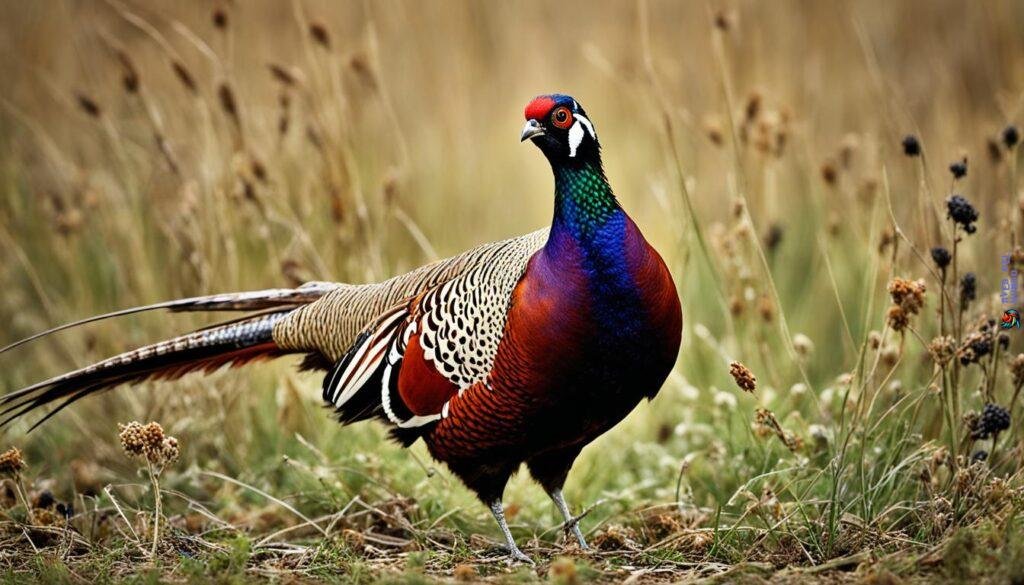
Commercial Pellets and Nutritional Balance
Commercial pellets are a top choice for feeding pheasants. They meet the birds’ nutritional needs well. These pellets are made to provide all the nutrients pheasants need, including the best seeds. They help keep the birds healthy in your yard.
Understanding Protein Content in Pheasant Feeds
Protein is very important for pheasants. It helps them grow strong feathers and stay healthy. You should choose feeds that have about 17% protein, as recommended for adult pheasants. Below, you can see different feeds and how much protein they have:
| Type of Feed | Protein Content | Benefits |
|---|---|---|
| Commercial Pheasant Pellets | 17% | Formulated for adult birds, supports maintenance needs |
| Turkey Feed Alternative | 15-20% | Similar in composition, acceptable when pheasant feed is unavailable |
| Game Bird Maintenance Feed | 14% | Suitable for pheasants in non-breeding season |
| Natural Seeds and Grains | Varies | Ideal for foraging practice, enhances diet diversity |
Don’t forget, pheasants also need clean water and seeds. These help them behave naturally by foraging. And they make your yard an exciting place for birds.
Introducing Variety: Plants and Insects in Pheasant Diets
To keep pheasants happy and healthy, you need a varied diet. Offering different plants, vegetables, and insects matches their natural eating habits. This is vital for those feeding wild birds with DIY bird feeders, or looking out for pheasants’ well-being.
The Role of Plants and Vegetables
Plants and veggies are more than just food for pheasants. They’re a fun way for them to eat when pecking in bird feeder placement areas. They also provide vital nutrients that boost their health. Foods like kale, spinach, and dandelions are packed with vitamins that support eyesight and blood health.
Incorporating Insects and Animal Protein
Adding insects to the diet is key for pheasants. Creatures like mealworms and crickets are not just good for protein. They make feeding time exciting, showing pheasants’ natural hunting behaviors.
Wondering how to offer a varied diet to your pheasants? Below is a table with the best plants and insects to give them:
| Plant Source | Benefits | Insect Source | Benefits |
|---|---|---|---|
| Kale | High in vitamins A, K, C, and manganese | Mealworms | Rich in protein and fat |
| Spinach | Contains iron, calcium, and folic acid | Crickets | Good protein source, also offers niacin and zinc |
| Dandelions | Excellent vitamins A, C, and K profile | Earthworms | Provide protein and are a natural food source in the wild |
Feeding pheasants isn’t just about sticking to a schedule. It means committing to their overall health and happiness. Using DIY bird feeders and smart bird feeder placement lets you offer a diverse and nutritious diet to these beautiful birds.
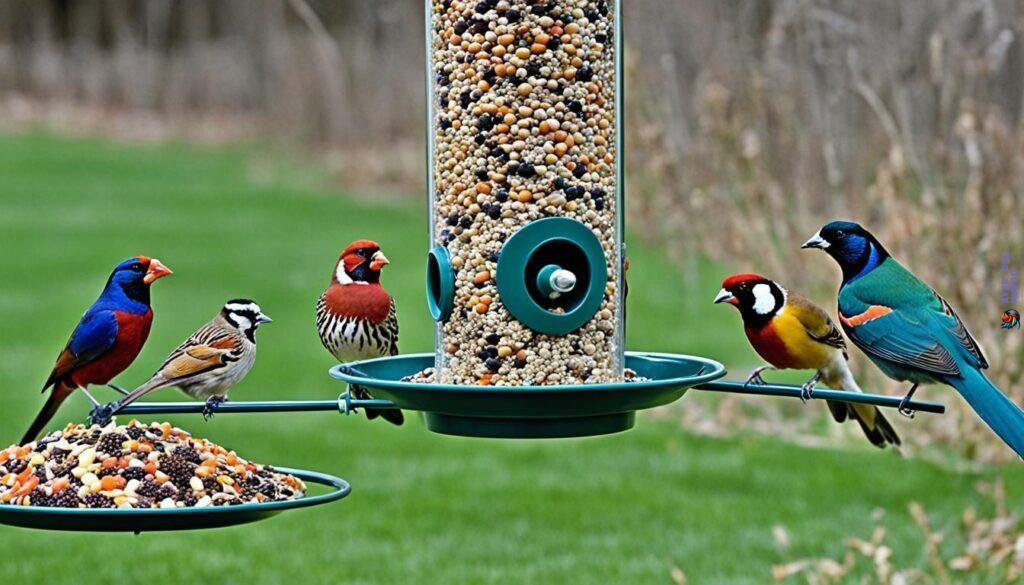
Pheasant Feeder Placement and Care
Setting up a feeding area is key to attracting birds to your yard. Choosing the right spot for a feeder and keeping it clean matters a lot. It keeps the best bird seeds fresh and makes sure birds are safe while eating.
Optimal Locations for Feeders
Finding the perfect place for your feeder is about balance. It should be in a spot that birds flying above can see. This is often where a forest meets a field. Yet, it shouldn’t be so open that predators can easily spot them. Birds like pheasants need nearby cover like bushes or small trees to feel safe. They can quickly hide if they sense danger. Also, if you put feeders near places where birds naturally look for food, they’ll likely visit more.
Maintenance Tips for Hygienic Feeding
Keeping your feeders clean is very important. By doing this, you help prevent diseases and keep visiting birds healthy. Always fill your feeders with the best bird seeds to ensure birds get the nutrients they need. Look out for spoiled food, especially when it’s wet outside, and throw away any old seeds to avoid attracting pests.
| Feeder Placement Tip | Reason | Benefits |
|---|---|---|
| Near Natural Cover | Provides quick escape routes | Enhances safety, increases visit frequency |
| Avoid Low Ground Spots | Prevents accumulation of dampness | Reduces disease, keeps seeds fresh |
| Visibility from Above | Attracts birds in flight | Encourages new visitors, aids in foraging |
| Feeder Hygiene | Prevents disease and pests | Protects bird health, ensures return visits |

Avian Health: The Impact of Proper Nutrition on Pheasants
Proper nutrition is key for the health of common backyard birds like pheasants. It impacts their physical health and how they interact with others. Following feeding advice from bird experts is essential. It prevents malnutrition and ensures they get the right foods.
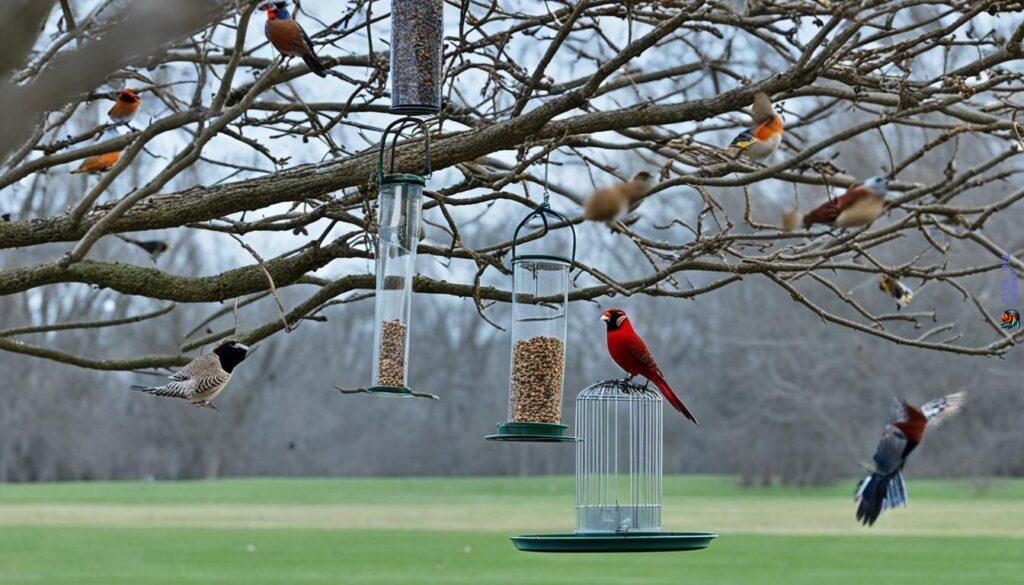
Avoiding Nutritional Deficiencies
Pheasants need the right nutrition to stay healthy. Without it, they might not grow well, can get sick easily, and lose energy. Using DIY bird feeders to provide varied nutrition can help. This mimics what they’d find in the wild.
Monitoring Health and Growth Progress
Watching pheasants’ health and growth is crucial. This helps catch any problems early. Keeping track of their development can show if they’re not getting enough nutrients or if they’re ill. Quick action is key to keeping them healthy. Proper feeder placement and regular meals help a lot.
| Nutrient | Function | Food Source |
|---|---|---|
| Protein | Growth and repair | Commercial feed, insects |
| Vitamin A | Vision and immune health | Leafy greens, carrots |
| Calcium | Bone development | Crushed eggshells, oyster shell |
| B12 | Red blood cell formation | Liver, eggs |
Tips for Attracting Pheasants to Your Yard with Proper Feeding
Want to make your yard a welcoming spot for pheasants? It starts with knowing what they like to eat. You can create a perfect place for them by choosing the right bird seeds. This way, your yard becomes a popular spot for these beautiful birds. They will be healthy and happy in your welcoming habitat.
Choosing the Right Seeds and Feeds
Attracting birds starts with picking the right food. Pheasants love a variety of protein-rich foods. Look for top-quality game bird feed. Since pheasants like to eat off the ground, spread out seeds they naturally enjoy. Many brands have the perfect mix of nutrients. This makes it easy to feed these birds well.
Creating a Pheasant-Friendly Environment
Your yard setup also matters in attracting pheasants. Place bird feeders where pheasants feel safe and undisturbed. Add native shrubs and trees for them to hide from predators. Keep the feeding area clean to prevent diseases. This makes sure pheasants are healthy and want to come back. Following these tips creates a great place for them.
